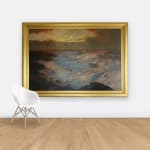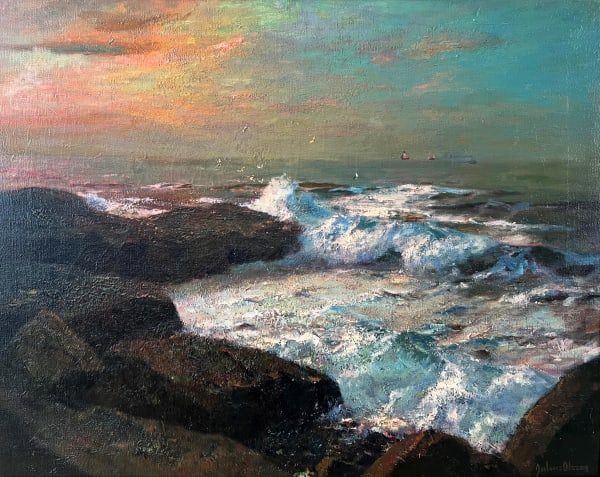
Stormy Evening on the Cornish Coast 1912, by Julius Olsson

Stormy Evening on the Cornish Coast on wall. Julius Olsson, 1912
Julius Olsson 1864-1942
Framed: 161 cm x 204 cm (63.4 x 80.3 ins.)
Further images
Provenance
Previously with The Leicester Galleries, London (2007)
Exhibitions
Royal Academy Summer Exhibition, 1912 (exhibit 359)
The Leicester Galleries at Grosvenor House, 2005
Penlee House Gallery & Museum, 'Compass'd by the Inviolate Sea', 18 June to 3 Sept 2016
Literature
The Exhibition of the Royal Academy, 1912 catalogue (P18).
Olsson’s genius was partly his ability to capture a millisecond’s drama and the kaleidoscope of light and shadow in crashing waves and explosive surf. The qualities required to be Julius Olsson, marine artist, are best summarised, inadvertently, by the man himself: ‘… for one whose heart draws him to the sea must, in the first place, have an exceptionally retentive memory, and be able to grasp in a few moments the effect of the ever-changing movements of the sea and sky; he must have a delicate and subtle sense of colour, and have the ability to place the main features of his impression of the subject on the canvas with a few strokes of the brush, and, besides this, he must be prepared to fight the brave fight with the elements, which will be frequently against him.’
The most famous example of Julius Olsson’s romantic naturalism is ‘Moonlit Shore’, exhibited at the Royal Academy in 1911 and purchased by the Chantry bequest for the Tate. Encouraged by the Tate purchase, Olsson moved to London in 1912, the year he painted ‘Stormy Evening on the Cornish Coast’. This painting was his major exhibit at the Royal Academy the year after Moonlit Shore. It’s another work by the artist at the height of his powers. The RA catalogue records Olsson’s address as 11 Avenue Studios, 76 Fulham Road so the artist had already moved by that summer. 'Stormy Evening on the Cornish Coast' is therefore likely to be the last significant work painted in St Ives by the father of the original St Ives school.
-
 Julius OlssonMoonlit SkyOil on canvas60.9 cm x 76.2 cmSold
Julius OlssonMoonlit SkyOil on canvas60.9 cm x 76.2 cmSold
Framed: 77.0 cm x 92.2 cm -
 Julius OlssonSt Ives Bay, MoonlightOil on canvas35.5 x 45.7 cm (14 x 18 ins)Sold
Julius OlssonSt Ives Bay, MoonlightOil on canvas35.5 x 45.7 cm (14 x 18 ins)Sold
54.7 x 64.7 cm (21.5 x 25.5 ins) -
 Julius OlssonEvening shipping across Carbis Bay, c. 1910Oil on canvas60.9 x 76.2 cm (24 x 30 ins.)Sold
Julius OlssonEvening shipping across Carbis Bay, c. 1910Oil on canvas60.9 x 76.2 cm (24 x 30 ins.)Sold
Framed: 83.8 x 99.0 cm (33 x 39 ins.) -
 Julius OlssonMoonlit Fleet in St Ives Bay, c. 1911Oil on canvas45.7 x 61 cm (18 x 24 ins).Sold
Julius OlssonMoonlit Fleet in St Ives Bay, c. 1911Oil on canvas45.7 x 61 cm (18 x 24 ins).Sold
Framed: 59.7 x 74.9 cm (23 1/2 x 29 1/2 ") -
 Julius OlssonStormy Evening on the Cornish Coast, 1912Oil on canvas139 cm x 183 cm (54.7 x 72 ins.)
Julius OlssonStormy Evening on the Cornish Coast, 1912Oil on canvas139 cm x 183 cm (54.7 x 72 ins.)
Framed: 161 cm x 204 cm (63.4 x 80.3 ins.) -
 Julius OlssonLast EmbersOil on canvas61 x 76cm (24 x 29 15/16ins.)
Julius OlssonLast EmbersOil on canvas61 x 76cm (24 x 29 15/16ins.)
Framed: 83.8 x 99.7cm (33 x 39 1/4ins.)











